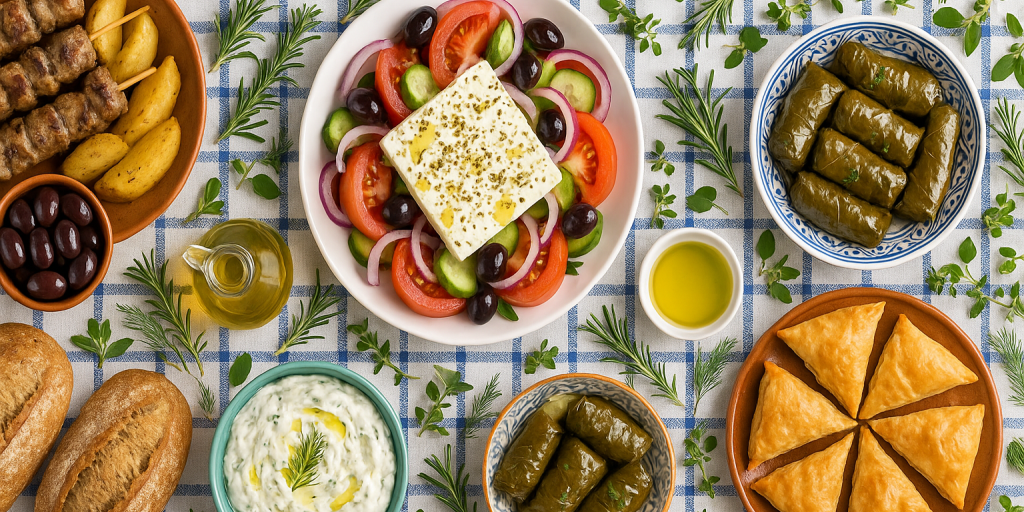
When people think of Greece, their minds often drift to whitewashed villages, turquoise seas, and tables overflowing with delicious food. Greek cuisine is more than just nourishment—it is a reflection of history, geography, and a culture that values family, hospitality, and celebration. From island tavernas to urban fine-dining restaurants, Greek food tells a story of simplicity, seasonality, and community.
In this article, we’ll explore the traditional foods most loved in Greece, while also looking at how modern tastes have expanded to include global influences, giving rise to restaurants like Okio in Athens.
Bread, Olive Oil, and Meze Culture
Every Greek meal begins with bread and olive oil. Bread has been at the heart of Greek dining since ancient times, often accompanied by local olives or a drizzle of golden extra virgin olive oil. Olive trees, a symbol of peace and prosperity, thrive across the country and produce some of the world’s finest oils.
Another cornerstone of Greek dining is the tradition of meze—small plates meant to be shared. Meze might include tzatziki (yogurt, cucumber, and garlic dip), melitzanosalata (eggplant dip), taramasalata (fish roe spread), or dolmades (stuffed grape leaves). These bites are enjoyed alongside ouzo, tsipouro, or wine, encouraging conversation and lingering at the table.
Fresh Vegetables and Iconic Salads
Seasonality plays a central role in Greek cuisine. Tomatoes, cucumbers, peppers, onions, and herbs burst with flavour under the Mediterranean sun. The famous horiatiki (Greek salad) is a simple yet iconic dish: ripe tomatoes, cucumbers, green peppers, red onion, olives, and a thick slab of feta cheese, all drizzled with olive oil and sprinkled with oregano.
Greeks eat vegetables in abundance—not just in salads, but also in slow-cooked stews and oven-baked casseroles such as briam (roasted vegetables) or fasolakia ladera (green beans in olive oil and tomato).
Cheese and Dairy
Cheese is everywhere in Greek cooking. Feta is the most famous, but there are dozens of regional varieties—kefalotyri, graviera, and manouri, to name a few. Yogurt, thick and creamy, is another staple, used both in savoury dishes like tzatziki and in desserts with honey and walnuts.
Meat and Seafood
While Greeks enjoy lamb and pork in traditional dishes, seafood plays a starring role in coastal regions and islands. Grilled octopus, fried calamari, and baked fish are beloved staples. Lamb, often roasted for Easter feasts, symbolizes celebration and family gathering. Street food like souvlaki and gyros are everyday favourites, offering a quick taste of seasoned meat wrapped in warm pita with tomato, onion, and tzatziki.
Pulses and Grains
Lentils, beans, and chickpeas form the backbone of many traditional meals, especially in villages where plant-based cooking has long been the norm. Dishes like revithia soupa (chickpea soup) or fasolada (bean soup, sometimes called Greece’s national dish) showcase how humble ingredients can be transformed into hearty, comforting meals.
Grains, too, are central—from bulgur in pilafs to phyllo pastry used in savoury pies such as spanakopita (spinach pie) and tiropita (cheese pie).
Sweets and Celebrations
No Greek celebration is complete without sweets. Baklava, layers of phyllo pastry with nuts and honey syrup, is world-famous. Loukoumades, bite-sized doughnuts drizzled with honey and cinnamon, are a nostalgic childhood treat. At Easter, red-dyed eggs and tsoureki (sweet braided bread) mark the season, while Christmas brings melomakarona (honey cookies) and kourabiedes (almond butter cookies).
The Modern Greek Table: A Taste for the World
While traditional foods remain at the heart of daily life, Greeks are also increasingly curious about global flavours. Especially in cities like Athens, there is a growing appetite for international cuisine—Asian, Latin American, Middle Eastern, and beyond.
This is where restaurants like Okio step in. Located in the heart of Athens, Okio has gained recognition for blending Mediterranean sensibilities with Asian influences, offering locals and visitors alike a new dining experience that respects tradition while embracing global creativity. For many Greeks who enjoy variety, restaurants like Okio provide a refreshing alternative to the familiar, while still celebrating the values of sharing, quality, and seasonality that define Greek food culture.
“Greek cuisine is built on simple ingredients—olive oil, bread, vegetables, cheese, pulses, and fresh seafood—that come together in dishes loved for centuries. Yet Greece is also evolving. While the tavernas and home-cooked classics remain central to the culture, there is also room for modern dining experiences and international flavours.”
Whether you’re enjoying a plate of grilled octopus by the sea, or tasting a fusion creation at a restaurant like Okio in Athens, food in Greece continues to be what it has always been: a celebration of life, community, and flavour.
